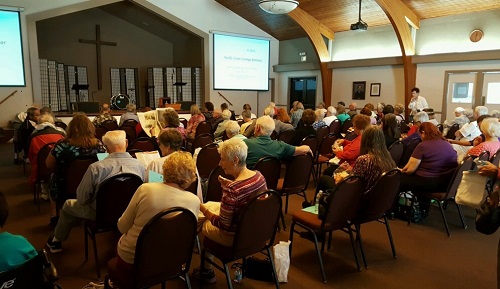Urinary Incontinence
 Bladder control is one of the most common health problems for women. Millions of women experience involuntary loss of urine called urinary incontinence (UI). While many women believe urinary incontinence only affects older women, the truth is that women of all ages may have urine leakage.
Bladder control is one of the most common health problems for women. Millions of women experience involuntary loss of urine called urinary incontinence (UI). While many women believe urinary incontinence only affects older women, the truth is that women of all ages may have urine leakage.
Estimates vary considerably but, overall, approximately 25% to 45% of women suffer from urinary incontinence. It is more common as women get older. The incidence is 20% – 30% in young women, 30% – 40% in middle age women and more than 50% in older women. Those are staggering numbers and suggest that urinary incontinence is the most common health concern for women.
Urinary incontinence is twice as common in women as it is in men. Pregnancy and childbirth, menopause and the structure of the female urinary tract are just a few of the factors that account for this difference. Urinary incontinence symptoms range from being mildly bothersome to totally debilitating. For many women, the risk of public embarrassment keeps them from enjoying many activities they love. It can also result in a loss of intimacy due to urine loss during sexual activity and cause tremendous emotional distress.
You don’t need to be incontinent to have a bladder control problem. Millions of women suffer from symptoms of an overactive bladder. That can cause frequent and sudden urges to urinate and control your daily life. No matter what type of bladder control problem you have, you don’t be embarrassed by your condition. You are not alone! Learn more about how we can help.
WHAT ARE THE TYPES OF BLADDER CONTROL PROBLEMS?

Dr. Pugach and Evans Tran, PA were the guest speakers on March 30, 2017 at Los Alamitos Medical Center’s Premier Advantage community education seminar.
Dr. Pugach spoke on “Innovative Treatments for Bladder Control” and Evans Tran, PA discussed Pelvic Floor Rehabilitation.
View Evan Tran’s, PA educational videos on bladder control problems and treatments for women.
INCONTINENCE
Bladder control problems are referred to as incontinence when there is uncontrolled leakage of urine that occurs with movement, exercise, coughing, sneezing, laughing or sudden strong urges to urinate that cannot be stopped.
For proper treatment, it is important to have a precise diagnosis of your bladder control problem. There are five principal types of urinary incontinence:
Stress incontinence – leaking urine during a physical activities such as, exercising or lifting or when laughing, sneezing and coughing. If your pelvic floor muscles, (vagina and supporting bladder ligaments) weaken, your bladder can move downward, pushing slightly out of the bottom of the pelvis toward the vagina. The urethra can lose its supporting tissue allowing it to move excessively. Either of these conditions can prevent muscles that ordinarily force the urethra to close from squeezing as tightly as they should. As a result, urine can leak into the urethra whenever there is an increase in abdominal pressure (e.g., during physical activities, when laughing, etc.). Physical changes resulting from pregnancy and childbirth, and low estrogen levels that occur during and after menopause, play a significant role in the development of stress incontinence. It is the most common form of incontinence in women and, in most cases, can be effectively treated.
Urge incontinence – feeling an overwhelming need to urinate that cannot be controlled. It can occur anywhere and at any time. Whether you are walking with friends, shopping or just sitting at home, if you suffer from urge incontinence you know it can strike at any time. It is due to inappropriate bladder contractions and there are a multitude of causes. We can help.
Mixed incontinence – this is a combination of stress and urge incontinence. About 25% of incontinent women suffer from this. It is especially important that you have your diagnosis and care at a facility that knows how to distinguish between the two and offer effective treatments for both as we do in our Women’s Bladder Control Center of Excellence.
Overflow incontinence – leaking urine because your bladder doesn’t empty completely. Weak bladder muscles or a narrow urethra can cause overflow incontinence. Nerve damage from diabetes or other diseases, previous surgery in the pelvis, radiation, strokes or low estrogen levels occurring after menopause are just a few of the reasons. Overflow incontinence is more common in men than in women.
Intrinsic Sphincter Deficiency – weakening of the sphincter muscles that are supposed to keep urine in the bladder until you are ready to urinate. From mild to severe, this condition can allow urine to leak out of your bladder all day long and when you are sleeping.
OVERACTIVE BLADDER (OAB)
A bladder control problem doesn’t just mean that urine leaks out inappropriately. Uncontrolled, frequent bladder contractions can force women to make sudden trips to the bathroom throughout the day and at night. Estimates are that as many as 37 million people in the United States suffer from an overactive bladder. It can control your life.
What Are the Symptoms of OAB?
A frequent need to urinate. This can occur at any time during the day, from the moment you wake up until you go to bed.
Nighttime urination. An OAB can wake you up throughout the night and prevent you from getting a good nights sleep and feeling rested in the morning
Urgency. The need to suddenly urinate can strike at any time and it doesn’t matter where you are. It doesn’t matter what position you are in although it’s more common when standing or changing from a sitting to a standing position. It can take control of your life, making you plan your daily activities around the location of bathrooms.
What Causes Urinary Incontinence?
There are dozens and dozens of potential causes or contributing factors. Our focus at Pacific Coast Urology’s Women’s Bladder Control Center of Excellence is to determine which ones are most responsible for a patient’s symptoms so that we can provide effective treatment options.
Here is a partial list of possible causes of bladder control problems:
- Changes in the pelvic area from pregnancy. Pressure and stretching during pregnancy, and the tremendous stresses of delivery, can have long lasting effects.
- An overactive bladder muscle
- Bladder infections
- Side effects of medications
- Changes in hormone levels (menopause)
- Neurologic (nerve) conditions
- Back injuries
- Pelvic and abdominal surgery including hysterectomy and colon surgery
- Side effects of radiation
- A previous stroke
- Pelvic Organ Prolapse – when the bladder, intestine or colon protrude into the vagina
- A sedentary lifestyle
- Tobacco use
Sometimes, difficulty with bladder control can be a sign of a more serious disease, such as bladder cancer, and early diagnosis and treatment can lead to a cure.
When Should You Seek Treatment for a Bladder Control Problem?
That’s an easy question to answer – when your symptoms start to bother you. When that happens varies dramatically from woman to woman. For some, even a small amount of leakage that requires using one mini pad per day is too much. For others, it’s when multiple large pads or diapers are needed. For some, it’s waking up once or twice at night to urinate. For others, it’s being afraid to leave home for fear of embarrassing accidents in public.
Here’s a brief checklist so you can assess how much your bladder control problem may be affecting you:
- Do you feel the sudden and uncontrollable urges to urinate during the day?
- Do you have accidental leakage of urine?
- How much leaks out?
- Do you wear pads or diapers?
- How much are you spending for them?
- Do you frequently get up at night to go the bathroom?
- Does your bladder control problem limit you or distract you from work or daily activities?
- Do you limit or restrict you social activities because of possible incontinence?
- Do you limit or fear sexual activity because of leakage or a sudden need to urinate?
- Do you take or have you taken medication for your overactive bladder?
- Is the medication effective or does it cause side effects?
- Do you have a sensation of vaginal fullness due to a dropped bladder?
If you answered YES, to ANY of these questions, it may be time to seek help. We’re here at the Women’s Bladder Control Center of Excellence to provide the care you need.
DIAGNOSTIC AND TREATMENT OPTIONS
At Pacific Coast Urology’s Women’s Bladder Control Center of Excellence we offer in-office diagnostic testing and we focus on minimally invasive treatment options. You’ll find a smiling welcome from our caring professional staff. Are you embarrassed about talking to a male physician about your bladder control problem? No problem – Evans Tran, Dr. Robert Pugach’s highly credentialed physician assistant, specializes in bladder control problems. She and Dr. Pugach review all patients together. It’s your choice whom you’d like to see.
Some of the innovative, minimally invasive solutions we offer for bladder control problems include:
Acupuncture – believe it or not, the U.S. FDA approved this for bladder control many years ago. It’s called Posterior Tibial Nerve Stimulation (PTNS). The Chinese call the posterior tibial nerve the “kidney-bladder pathway” and it can reduce overactive bladder symptoms in up to 60% of patients!
Biofeedback – in office, computer assisted exercises that teach you how to strengthen the muscles that can prevent urine loss and decrease sudden or frequent urges to urinate.
BOTOX® – it’s not just for wrinkles anymore! When injected into the .bladder muscle, it can reduce or eliminate frequent, bothersome contractions.
Hormone Replacement – while this is always an appropriate concern for women, many find significant relief with low dose estrogen cream.
Interstim® Bladder Therapy – this tiny battery device is placed under your skin in the lower back. It’s about the size of two half dollar coins glued together and is the most effective treatment of an overactive bladder.
Pelvic Floor Rehabilitation – Pelvic Floor Rehabilitation is designed to strengthen the pelvic floor muscles with a targeted in-office therapy and a home exercise regimen. The therapy is customized to each patient’s needs.
Medications – we stay current about the latest medications that can help to reduce or eliminate bladder control problems without causing the side effects associated with older medicines.
Outpatient surgery – while we reserve surgical procedures for women who do not have a satisfactory response to our minimally invasive treatment options, we regularly perform outpatient procedures like urethral slings and hammocks. We work closely with local gynecologists to offer surgical correction of pelvic organ prolapse such as cystoceles (a dropped bladder), rectoceles (when the rectal wall protrudes into the vagina) and enteroceles (where the intestine presses into the vagina).
Bladder control problems are the most common health concern for women. We specialize in the diagnosis and treatment of them in Pacific Coast Urology’s Women’s Bladder Control Center of Excellence.
If you have a bladder control problem, call us at 888-735-4336 to schedule you personal consultation.





